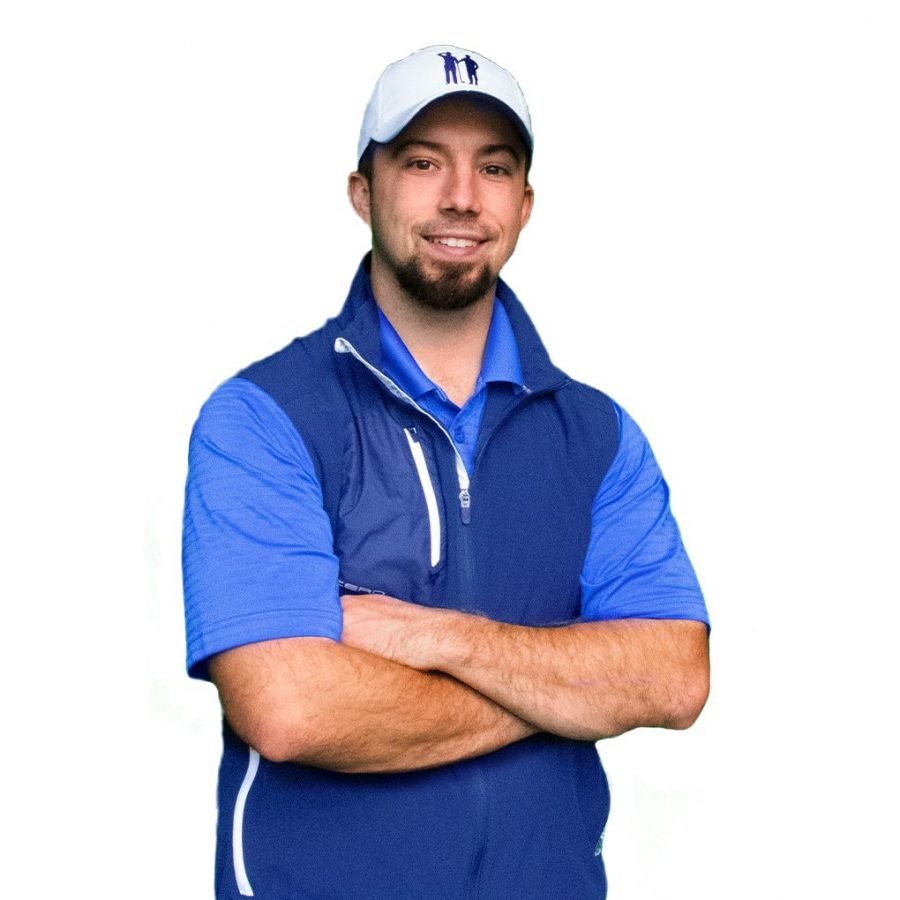Open or Closed? How to Train Face Angle With Purpose
Is Your Clubface Really Square?
Most golfers have no idea where their clubface is pointing during the swing. They make a good move, strike the ball cleanly, and then wonder why the shot starts left or sails right.
What they don’t realize is that face angle—not swing path—is often the real culprit.
Elite ball-strikers don’t guess where the face is. They train it on purpose. If you’ve ever hit a shot and thought, “That felt great, but it went the wrong way,” this article is for you.
You’ll learn how to identify your face angle tendencies and build drills to train real control over the face—so your shots start on line more often.
Resource: Want fresh practice plans sent to you each week? Check out The Practice Club, our online member community where we create fun, challenging practice routines sent out every Sunday. Paired with golf swing reviews, you can submit your swing to our coaches for quick feedback and drills to improve your swing faster.
1. What “Open” and “Closed” Really Mean
Target Line vs. Path Reference
When golfers talk about an “open” or “closed” face, they usually mean relative to the target. That’s important, because the face-to-target relationship determines the ball’s starting direction.
But there’s another relationship to understand: face-to-path. That’s the face angle measured against your club’s swing direction. This relationship determines curvature—fade or draw.
For example:
- Face 0°, Path -5° = face is open to path → fade
- Face -2°, Path +3° = face is closed to path → draw
To hit predictable shots, you need to control both relationships—face-to-target and face-to-path.
Typical Face Tendencies by Handicap
Most higher handicap players tend to leave the face open at impact. This causes the ball to start right and either stay there or slice more, especially when paired with an out-to-in swing path.
Mid-handicap players often have a face that’s closed to the target but still open to the path. That leads to pull-slices—shots that start left and then curve right.
Better players learn to match face and path intentionally to hit a draw or fade on command. They understand where the face is pointing and how it needs to relate to their path based on the shot they want to hit.
Free 7 Day Practice Plan
Get step by step drills to follow for fast improvement.
2. What Causes Open or Closed Clubfaces
At Setup
Your clubface issues often start before the club even moves. A weak grip—where your hands are turned too far toward the target—can lead to an open face at impact. You’ll have to work hard during the swing to square it, and most golfers don’t succeed.
A strong grip, where both hands are rotated more away from the target, tends to produce a closed face unless timed perfectly. While some players use a strong grip effectively, it can also make the face shut down too early if not managed correctly.
Also, how your clubface is set at address matters. If it’s open or closed to the target before you swing, you’re already starting behind.
During the Swing
Once the swing starts, wrist angles take over. An open face is commonly caused by a cupped lead wrist (extended) in the backswing and downswing. This leaves the face open unless you make a strong compensating move late in the swing.
Early release or overuse of the trail hand can also leave the face open. You’ll often see this in players who flip at the ball or try to “help” it into the air.
On the flip side, a bowed lead wrist (flexion) typically closes the face early. Players with very strong grips or an overly active body rotation can shut the face too quickly and pull shots left. This also shows up when players try to “hold off” their release with too much shaft lean and tension.
Impact Location (Gear Effect)
Even with a good swing, off-center contact can twist the face. A heel strike causes the face to twist open, leading to shots that start right or fade more than expected. A toe strike twists the face closed, often causing pull-draws or hooks.
This is due to gear effect—especially on drivers. That’s why it’s critical to know not just where the face is pointing, but where you’re hitting the ball on the face.
3. How to Check Your Clubface in the Swing
Address and Takeaway Checkpoints
One of the easiest places to start is with your setup and takeaway. At address, the clubface should be square to your target—not flared open or closed. Make sure your grip, alignment, and ball position support that.
As you take the club back, check the face when the shaft is parallel to the ground. A good checkpoint is to see if the face matches your spine angle. If it does, your clubface is likely in a neutral position. If it’s too open (toe pointing straight up), you may be setting yourself up for directional issues.
At the top of your swing, the toe of the club should be slightly lower than the heel—not completely vertical or overly shut. Matching toe angle to your lead arm’s angle is another helpful reference to maintain consistency.
Video, Mirrors, and HackMotion
You don’t need a launch monitor to train face angle. Video and mirrors are powerful tools. Film your swing from down the line and look for face angle at takeaway, at the top, and in the downswing. Are you cupped? Bowed? Neutral?
Mirrors work great for rehearsing the proper look. You can even do slow-motion drills in front of a mirror to reinforce the right feels.
If you have access to HackMotion or similar wrist sensors, you can go a step further and measure your wrist angles in real time. These tools show you exactly how much extension or flexion is happening in your swing, helping you control the clubface with precision.
Impact Spray or Impact Tape
To eliminate gear effect as a variable, use foot spray or impact tape on your clubface. If your face control seems inconsistent, it may not be your wrist angles—it might be contact location.
Heel and toe strikes twist the face open or closed, distorting your start line and curvature. Centered contact allows your intended face angle to actually show up in the ball flight. Check it often if your shots don’t match what you feel.

4. Face Control Drills for Purposeful Training
Quarter-Swing Start Line Game
This drill builds awareness of where your clubface is pointing at impact. Using a wedge or short iron, hit 30–50 yard shots and try to start the ball:
- Left of the target
- Right of the target
- Straight at the target
Keep your swing path neutral—just adjust the face angle through setup and wrist position. This drill teaches you to manipulate the start line intentionally and feel the cause-and-effect relationship between your face angle and ball direction.
Gate Drill with Alignment Sticks
Place two alignment sticks in the ground or on the range mat about two feet in front of your ball, slightly wider than your clubhead. This forms a “gate” through which your ball must travel.
The goal is to start your shots between the sticks. If the ball hits the right stick, your face was likely too open. If it hits the left stick, it was likely too closed. This visual feedback is immediate and forces you to adjust your face angle to hit clean starts.
You can even vary your target: try fading the ball through the right side of the gate or drawing it through the left. This will help match face-to-path relationships.
Wrist Flexion/Extension Progressions
Take a 9-iron or wedge and hit small swings focusing only on lead wrist angles.
- Start with exaggerated bowed wrist swings (flexion) to see how the ball starts left.
- Then switch to cupped wrist swings (extension) and observe the ball starting right.
- Finally, try to find a neutral feel that starts the ball on line.
This progression teaches your hands and brain what different wrist positions feel like—and how they affect the face at impact. The more you repeat it, the easier it becomes to control.
5. The Goal: Match Face to Intentional Path
The real magic happens when you start shaping shots on purpose. It’s not just about squaring the face—it’s about understanding how the face needs to relate to your swing path to hit your desired shot shape.
Here’s how the face-to-path relationship works in real-world terms:
- Straight Shot
Face is square to the target, and path is also square. There’s no curve, and the ball flies straight if contact is centered. - Draw
Face is slightly closed to the target (but open to the path). For example:
Face = 0°, Path = +4°
That creates a small draw that starts on line and gently curves left. - Fade
Face is slightly open to the target (but closed to the path). For example:
Face = 0°, Path = -3°
The ball starts near the target and curves slightly right.
Most amateurs focus only on swing path, trying to change their direction or shape with footwork or body movement. But elite players match the face to the shot first—then let the path work around it. That’s the key difference.
Once you know how to position the face with intention, shaping shots becomes a choice, not a mystery.
Conclusion: Stop Hoping—Start Shaping
If you’ve ever stood over a ball and hoped it would go straight, you’re not alone. But hope isn’t a strategy. Face angle is the single biggest factor in where your ball starts—and how it curves.
By learning how to recognize your tendencies, control your grip and wrist angles, and train specific face positions, you take control of your game. You don’t have to guess anymore. With purpose and practice, you can shape your shots, hit your targets, and play more confident golf.
Golf Practice Plan – What to Do & Not To Do
Wonder why you’re not getting better as fast as you want to be? Here’s your proven system to follow step by step that hundreds of golfers like you are following each month. Our students send us emails frequently praising these practice plans and how much they’ve improved at golf.
Get access to our Practice Plans built for all 3 skill levels (Beginners, Intermediate, and Advanced Golfers).
You’ll learn what to do at the golf course to improve your score and skills and what not to do. Just follow these plans step by step. It’s made easy for you. Plus see our videos, worksheets, and training aid recommendations.
Thanks for reading today’s article!
Nick Foy – Golf Instructor

